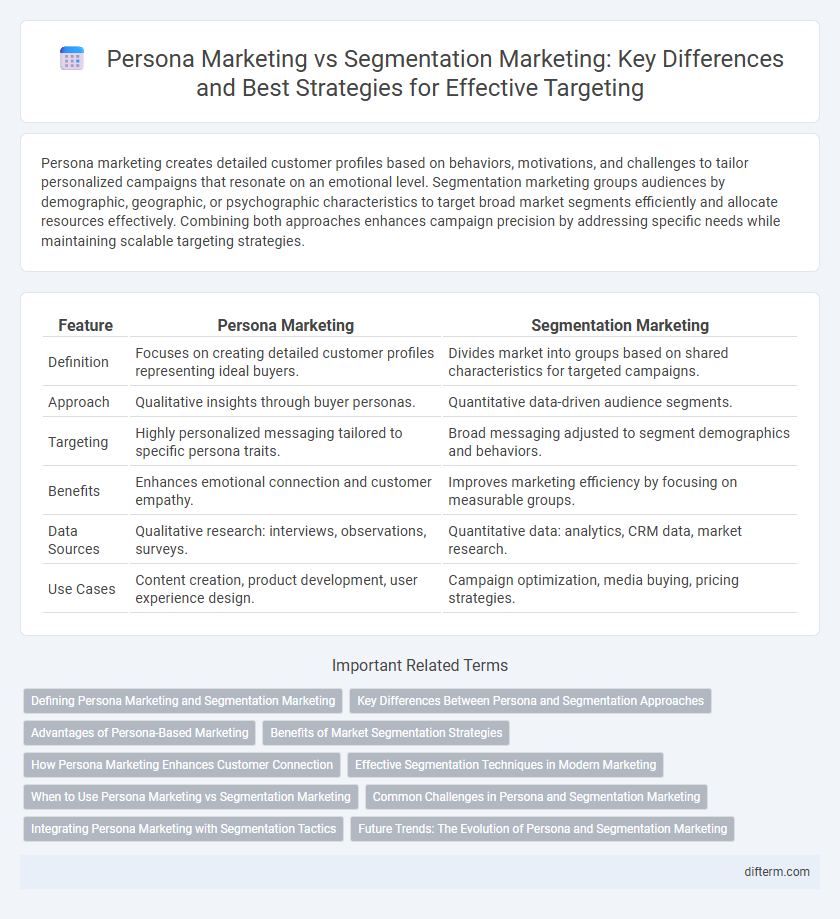Persona marketing creates detailed customer profiles based on behaviors, motivations, and challenges to tailor personalized campaigns that resonate on an emotional level. Segmentation marketing groups audiences by demographic, geographic, or psychographic characteristics to target broad market segments efficiently and allocate resources effectively. Combining both approaches enhances campaign precision by addressing specific needs while maintaining scalable targeting strategies.
Table of Comparison
| Feature | Persona Marketing | Segmentation Marketing |
|---|---|---|
| Definition | Focuses on creating detailed customer profiles representing ideal buyers. | Divides market into groups based on shared characteristics for targeted campaigns. |
| Approach | Qualitative insights through buyer personas. | Quantitative data-driven audience segments. |
| Targeting | Highly personalized messaging tailored to specific persona traits. | Broad messaging adjusted to segment demographics and behaviors. |
| Benefits | Enhances emotional connection and customer empathy. | Improves marketing efficiency by focusing on measurable groups. |
| Data Sources | Qualitative research: interviews, observations, surveys. | Quantitative data: analytics, CRM data, market research. |
| Use Cases | Content creation, product development, user experience design. | Campaign optimization, media buying, pricing strategies. |
Defining Persona Marketing and Segmentation Marketing
Persona marketing involves creating detailed profiles that represent ideal customers by analyzing demographics, behaviors, motivations, and goals to tailor personalized marketing strategies. Segmentation marketing divides a broad market into smaller groups based on shared characteristics such as age, location, or purchasing behavior to optimize targeting and messaging. Both approaches aim to enhance marketing efficiency by delivering relevant content to specific audiences, but persona marketing offers deeper insight into individual customer needs and preferences.
Key Differences Between Persona and Segmentation Approaches
Persona marketing centers on creating detailed, fictional representations of ideal customers based on behaviors, motivations, and demographics to tailor personalized messaging. Segmentation marketing divides a broad audience into distinct groups based on shared characteristics such as age, location, or purchasing behavior for targeted campaign strategies. The key difference lies in personas providing nuanced, story-driven insights for individualized engagement, while segmentation categorizes audiences for broader, data-driven targeting.
Advantages of Persona-Based Marketing
Persona-based marketing enables highly tailored messaging by creating detailed profiles representing target customers, which enhances customer engagement and conversion rates. It facilitates deeper emotional connections by addressing specific pain points and preferences, leading to improved brand loyalty and customer retention. This approach outperforms traditional segmentation by delivering personalized experiences that resonate more effectively with individual buyer behaviors and motivations.
Benefits of Market Segmentation Strategies
Market segmentation strategies enable businesses to identify and target distinct customer groups based on demographics, behaviors, and preferences, resulting in highly personalized marketing campaigns. Segmentation improves resource allocation and enhances customer engagement by delivering relevant messages that resonate with specific audience needs. This targeted approach increases conversion rates and maximizes return on investment compared to broader persona marketing methods.
How Persona Marketing Enhances Customer Connection
Persona marketing enhances customer connection by creating detailed, realistic profiles that reflect actual customer behaviors, needs, and motivations, allowing brands to tailor messages with higher emotional relevance. Unlike segmentation marketing, which groups customers by broad demographics or behaviors, persona marketing digs deeper into psychological and lifestyle factors that drive purchasing decisions, fostering empathy and personalized interaction. This targeted approach improves engagement rates, builds stronger brand relationships, and drives customer loyalty through meaningful, customized experiences.
Effective Segmentation Techniques in Modern Marketing
Effective segmentation techniques in modern marketing leverage data-driven insights to categorize consumers based on demographics, psychographics, and behavior for precise targeting. Persona marketing builds detailed representations of ideal customers by integrating qualitative and quantitative data, enhancing personalized messaging and customer experience. Combining segmentation with persona development allows marketers to tailor strategies that increase engagement, conversion rates, and brand loyalty in competitive markets.
When to Use Persona Marketing vs Segmentation Marketing
Persona marketing excels when targeting niche audiences with highly personalized content based on detailed behavioral and psychographic insights. Segmentation marketing is more effective for broader audience groups, allowing for efficient allocation of resources by categorizing customers into demographic or geographic clusters. Use persona marketing for deep engagement and segmentation marketing to optimize reach and campaign scalability.
Common Challenges in Persona and Segmentation Marketing
Persona marketing and segmentation marketing both face challenges in accurately identifying and grouping target audiences due to evolving customer behaviors and diverse preferences. Data quality issues and reliance on outdated or incomplete information can lead to ineffective marketing strategies that fail to engage the right consumers. Aligning marketing messages consistently across segments and personas requires sophisticated tools and continuous audience analysis to ensure relevance and impact.
Integrating Persona Marketing with Segmentation Tactics
Integrating persona marketing with segmentation tactics enhances campaign precision by combining detailed customer profiles with broader demographic and behavioral groupings. This hybrid approach allows marketers to tailor messaging that resonates on an individual level while efficiently addressing group patterns, improving engagement and conversion rates. Utilizing data analytics to align personas within target segments ensures strategic allocation of resources and measurable marketing ROI.
Future Trends: The Evolution of Persona and Segmentation Marketing
Future trends in marketing reveal a shift towards integrating AI-driven analytics with persona and segmentation strategies to deliver hyper-personalized customer experiences. Advanced data modeling enables marketers to refine segments dynamically, creating fluid personas that evolve in real-time based on consumer behavior and preferences. This evolution leverages predictive insights to enhance targeting precision, driving higher engagement and conversion rates in increasingly competitive markets.
persona marketing vs segmentation marketing Infographic

 difterm.com
difterm.com